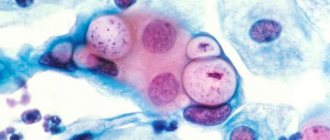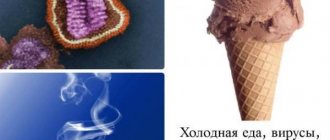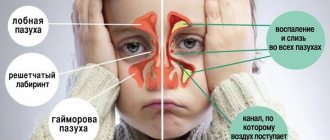Mononucleosis in children - main symptoms: Sore throat Pain in the lymph nodes Sore throat Dizziness Skin rash Brown urine Plaque on the tonsils Chills Swelling of the eyelids Fever Swollen lymph nodes
Mononucleosis most often affects children aged 3 to 10 years; it is less common in children under 2 years of age.
Mononucleosis in children is an infectious disease that has symptoms similar to influenza and sore throat, but unlike them, it can affect internal organs. The pathology is characterized by enlarged lymph nodes in different parts of the body. Most cases of infection are diagnosed in children between 3 and 10 years of age, but adults can also become infected. If treatment for mononucleosis is not started in a timely manner, dangerous complications may develop, including death.
Description
Scientists call the causative agent of infectious mononucleosis the Epstein-Barr virus, which belongs to the herpesvirus family. Sometimes a disease of cytomegalovirus origin occurs. The symptoms of mononucleosis do not depend on their type.
According to statistics, more than 90% of people over 30 years of age suffered from this disease in early childhood.
The Epstein-Barr virus develops in the mucous membrane of the mouth, spreading to the pharynx and tonsils. Through the blood it penetrates into the liver, heart muscles, spleen and lymph nodes. Often the pathology occurs in an acute form. In rare cases, complications occur due to weakened immunity and activation of secondary pathogenic microflora.
The incubation period of mononucleosis can last from 5 to 14-20 days. If the disease has become chronic, the patient's lymph nodes are constantly enlarged. He also has damage to vital organs - the brain, heart and nerve centers. The child's facial expressions are impaired and psychosis appears. In chronic pathology, the incubation period can last from 1 to several months.
Note! After recovery, the Epstein-Barr virus remains forever in the human body, but recurrent disease is very rare and only with a sharp decrease in immunity.
Experts distinguish 2 forms of mononucleosis:
- typical;
- atypical.
In the typical form, the child is bothered by pronounced signs of the disease, while in the atypical form, the symptoms are completely absent or they are subtle. In some cases, doctors find damage to the lungs, kidneys or heart.
According to the duration of the course, mononucleosis can be protracted and common. In the atypical form, the disease is more mild; the diagnosis is made by an infectious disease specialist after conducting a series of laboratory tests.
Clinical picture of the disease
Infectious mononucleosis in children can occur in acute, chronic and atypical forms. In this case, the severity of symptoms and the nature of the course of the viral infection are determined by its type.
Acute course of the disease
The incubation period of a viral infection ranges from 5 to 60 days. Acute mononucleosis is characterized by an abrupt onset. The patient's body temperature rises to high values (39-400 C), fever and chills appear. During the day, symptoms of general intoxication of the body develop: weakness, apathy, drowsiness, so children lie in bed most of the day.
In the acute form of mononucleosis, the following symptoms usually develop:
- lymph nodes in the neck and behind the ears enlarge;
- the mucous membrane of the nasopharynx swells, which causes difficulty in nasal breathing;
- a white coating appears on the tonsils, root of the tongue, palate, back wall of the pharynx;
- the liver and spleen increase in size. In severe cases, the organs become so enlarged that they can be visually replaced;
- herpetic rashes appear on the lips;
- A small, thick red rash occurs all over the body or in the neck, chest, back, and face. In infants, rashes appear on the elbows and back of the thighs;
- the skin in the area of the rash becomes rough and itching occurs. This symptom develops in 25% of children.
Important! You can become infected with mononucleosis from a patient during the incubation period, 5-7 days after the disease manifests itself.
Chronic form of infection
The duration of the acute stage of mononucleosis is usually 10-20 days. If viral particles remain in the body, a chronic form of herpes virus infection develops. In this case, damage to the liver and spleen does not always occur, but in all patients the lymph nodes are enlarged.
Experts were unable to determine the exact reasons for the disease becoming chronic. However, the following provoking factors are identified:
- decreased immunity;
- stressful situations;
- unbalanced and inadequate nutrition;
- Unhealthy Lifestyle;
- heavy physical and mental stress.
The chronic form of mononucleosis is characterized by identical symptoms to the acute stage, but the symptoms appear more mildly. In children, the temperature may rise to subfebrile levels (no more than 37.90 C). Rashes on the body rarely develop; inflammation of the throat does not cause severe pain. However, the child has increased fatigue, weakness, and drowsiness.
Sometimes chronic mononucleosis is accompanied by the development of the following symptoms from the digestive tract: constipation, diarrhea, nausea and vomiting. Often, patients note the occurrence of headache and muscle pain, reminiscent of flu-like soreness. The Epstein-Barr virus provokes a sharp decrease in immunity, so the body is attacked by other infectious agents that cause pharyngitis, pneumonia, HIV, and herpes on the face.
Atypical mononucleosis
This form of viral infection is not considered as a disease, but as a set of symptoms:
- the appearance in the bloodstream of a large number of atypical mononuclear cells;
- inflammation of the nasopharynx, tonsils;
- enlarged lymph nodes;
- development of allergic reactions.
Atypical mononucleosis is more common in schoolchildren in the spring and autumn.
Causes of infection
Epstein-Barr virus is transmitted in the following ways:
- Vertical. If a woman has infectious mononucleosis during pregnancy, she can infect the fetus.
- Parenteral. The infection enters the body through blood transfusion or intravenous injection with a non-sterile syringe.
- Contact. Occurs through saliva, for example, during a kiss.
- Airborne. Transmission occurs when an infected person coughs or sneezes.
In addition, you can become infected with the herpes virus by sharing dishes, toys, bedding or clothing with a sick person. The peak incidence is observed in autumn and spring. This is due to weakened immunity and hypothermia.
Prevention measures
After the initial infection, the Epstein-Barr virus is present in the human body in a latent form. There is a version of scientists according to which the parasite becomes more active when the immune system is weakened, and its concentration in the host’s saliva increases. This is an opportunity for the virus to “master” the body of a new host.
Specific measures for the prevention of mononucleosis have not yet been developed. It is important to increase the immunological resistance of the child’s body using hardening methods and regularly carry out vitamin therapy. Rinsing the mouth and nasopharynx with herbal infusions helps. After recovery, the child continues to feel significant weakness and fatigue for about a year. A fever and other symptoms are possible, which is why children who have been ill are exempt from vaccinations for a year.
Symptoms
Viral mononucleosis is characterized by the following symptoms:
- pain in the throat when swallowing;
- inflammation of the pharynx;
- proliferation of tonsils and plaque on them;
- labored breathing;
- headache;
- swelling in the nasal mucosa;
- snore;
- runny nose;
- pain in the side;
- increased body temperature;
- chills;
- inflammation and enlargement of lymph nodes;
- jaundice;
- chronic fatigue syndrome;
- dark color of urine;
- rash on the body;
- swelling of the eyelids;
- dizziness.
The child begins to refuse food and spends more time in bed. Symptoms such as rapid heartbeat and insomnia may occur.
Infectious mononucleosis in children can be acute or chronic.
The famous doctor Komarovsky notes that infectious mononucleosis, unlike tonsillitis, causes an enlargement of the liver and spleen, and also increases the level of mononuclear cells in the blood, which is detected during a laboratory test. The symptoms of the disease manifest themselves most clearly in children aged 6 to 15 years. If a child has a fever, this indicates that the body is actively fighting the infection. Chronic fatigue syndrome can last 3-4 months after the disappearance of other signs of pathology.
General information about the disease
Mononucleosis is a disease caused by a herpes virus. As a rule, the disease is observed in children from 3 to 7 years old and in adolescents. Very common in children's groups.
Infectious mononucleosis is a very easily transmitted disease
Transmitted by air . The virus penetrates the oral cavity, takes hold there and lives for up to 2-3 weeks, actively developing.
But you can also become infected by using shared utensils and toys. Teenagers are often affected by the disease. The infection is transmitted through kissing.
In the external environment, the virus quickly dies. High air temperature, high humidity and ultraviolet rays are the main enemies for the virus.
This is interesting! As a rule, every person suffers from mononucleosis at least once in their life . After suffering an illness, the body develops a strong immune system.
Signs of the disease
The incubation period can range from 2 weeks to a month . Once on the mucous membranes, the virus begins to actively multiply, then penetrates the blood, spreading throughout the body, at this time the lymph nodes begin to actively react to it, they increase in size, and the blood formula changes.
Advice! It is very important to correctly identify the disease at the initial stage. In this case, the doctor will prescribe treatment that will eliminate complications.
The main symptoms and signs of the disease are as follows:
- Sharp pain in the throat . It is difficult for the baby to swallow. In most cases, the tonsils increase in size, acquire a bright red tint, and a light yellow coating appears. Many parents confuse this symptom with a sore throat and start giving their child an antibiotic. This is one of the main mistakes. Remember, with mononucleosis, the baby will have a specific, unpleasant odor from the mouth.
- Swelling of the mucous membrane . Because of this, the child cannot breathe through his nose. In this case, there is no runny nose.
- Body aches and chills appear . The child becomes sleepy and may complain of headaches.
- Increase in body temperature to 39 degrees . At the same time, it is quite difficult to knock it down. Sometimes you have to resort to traditional methods (wiping). How long does the temperature last for mononucleosis in children? Doctors say that fever for 4-5 days is normal.
- Inflammation of the lymph nodes . They become larger and can be easily felt. In this case, there are no painful sensations. The lymph nodes in the groin, neck and armpits react especially actively. It is very rare to observe a clinical picture with enlarged lymph nodes in the abdominal cavity. With this phenomenon, compression of the nerve endings in the abdominal area occurs. The child experiences a cutting pain. An inexperienced doctor may confuse this with signs of appendicitis.
- Enlargement of some internal organs (liver, spleen) . This can be seen by doing an ultrasound of the abdomen. If the problem is not noticed in time, the spleen may rupture.
- Small rash on arms, face, back. At the same time, the papules are not edematous and not filled with liquid. They do not cause the child any discomfort at all and go away on their own in 2–3 days.
With mononucleosis, a rash appears that does not cause problems or pain to the child. - Swelling (especially in the eyelid area).
Differences from sore throat
Upon external examination, it is difficult to distinguish a sore throat from mononucleosis.
It is important! An experienced doctor will be able to diagnose the disease without any problems. Its main differences from sore throat are as follows:
- nasal congestion;
- enlarged liver and spleen;
- change in the general blood test.
Many parents, upon hearing a diagnosis of mononucleosis from a pediatrician, are immediately scared. Doctors assure that the disease can be treated quite quickly and effectively; it is only important to follow the recommendations of a specialist.
Diagnostics
To determine infectious mononucleosis, doctors use the following research methods:
- General blood analysis. Helps identify the number of leukocytes, monocytes, lymphocytes and changes in the erythrocyte sedimentation rate. Typically, all these indicators increase by 1.5 times when infected with a herpes virus.
- Blood chemistry. Shows the content of glucose and other substances in the blood. Using these data, the specialist evaluates the functioning of the kidneys, liver and other organs.
- Linked immunosorbent assay. Helps detect viral antibodies in blood serum.
- PCR analysis. Designed for accurate and rapid detection of viruses by DNA.
- Ultrasound examination of the abdominal organs. Demonstrates the condition of internal organs and their changes.
The main diagnostic value for infectious mononucleosis is a laboratory blood test for antibodies to the Epstein-Barr virus
Diagnostic measures
Infectious mononucleosis is quite difficult to diagnose, since the disease often resembles a common sore throat, and hematological changes are secondary. If the development of a herpetic infection is suspected, the following studies are prescribed:
- determination of IgG, IgM antibodies to the Epstein-Barr virus in the bloodstream;
- performing an ultrasound of internal organs (characteristic is an increase in the size of the liver and spleen);
- performing PCR to detect the DNA of herpes virus particles;
- general blood test. During the disease, the number of monocytes and lymphocytes increases, leukocytosis is detected, ESR increases, after 10 days atypical mononuclear cells appear (about 10%);
- blood chemistry. Characteristic signs of liver dysfunction appear.
As part of the differential diagnosis, the pediatrician must exclude the occurrence of tonsillitis, tonsillitis, acute leukemia, Botkin's disease, diphtheria of the pharynx, lymphogranulomatosis, which have similar symptoms.
Complications
In the absence of timely treatment, the child may experience the following consequences of infection:
- splenic rupture;
- inflammation of the thyroid or pancreas;
- pericarditis;
- myocarditis;
- autoimmune diseases;
- anemia;
- thrombocytopenia;
- decrease in the number of leukocytes in the blood;
- pneumonia;
- meningitis;
- inflammation of the spinal cord;
- encephalitis.
Definition
Mononucleosis is an infectious disease caused by the Epstein-Barr virus. Children under 10 years of age are most susceptible to it. The incubation period depends on the state of the immune system and the individual characteristics of the person. Signs of the disease may appear on the 5th day after infection, but sometimes the incubation period extends for up to two weeks. The virus greatly weakens the immune system, so additional pathological conditions often arise during the course of the disease.
Infectious mononucleosis has two forms of development.
- Acute, characterized by severe symptoms. If not treated promptly, it can lead to serious complications.
- Chronic. The most common form of the disease. Symptoms are almost completely absent, but the person is a virus carrier and remains infectious. Under the influence of reduced immunity, some signs of the disease may appear.
A large number of people are carriers of this virus without even knowing it, because many cases of infection are chronic and do not show characteristic symptoms. In some cases, symptoms may appear that many confuse with ARVI.
The virus, entering the mucous membranes, infects the cells of the immune system, beginning to actively multiply in them. These cells then spread the virus throughout the body, settling in the liver, spleen, lymph nodes and tonsils, causing them to become inflamed and, as a consequence, enlarged.
The virus dies quickly enough in an open environment, so infection is possible only through close contact.
How to treat infectious mononucleosis?
Antibacterial drugs do not act on viruses, so their use is inappropriate, and in some children they can cause allergic reactions. Only when a bacterial infection becomes active can the doctor prescribe antibiotics such as Azithromycin or Clarithromycin. In combination with them, probiotics should be taken to restore intestinal microflora. These include:
- Acipol;
- Acylact;
- Bificol;
- Linux;
- Lactobacterin.
To treat infectious mononucleosis, antipyretic drugs are used - Ibuprofen, Paracetamol or Panadol. Rinsing with furatsilin solution or soda will help relieve inflammation of the larynx. You can also use various herbal decoctions and infusions.
The most effective and safe antipyretic for children is Paracetamol
Antihistamines – Claritin or Zyrtec – will help eliminate allergic reactions and alleviate the symptoms of intoxication. To restore liver function, the doctor prescribes hepatoprotectors and choleretic agents. The most popular are Karsil and Essentiale.
Children's immunity can be strengthened with the help of drugs that have antiviral and immunomodulatory effects. These include the following:
- Anaferon;
- Cycloferon;
- Imudon;
- Lysobacter;
- Broncho-Munal.
If a child has severe swelling of the larynx, then therapy will not be possible without the use of hormonal drugs, for example, Prednisolone. If breathing is difficult, artificial ventilation may be performed. If a patient has a ruptured spleen, it is removed during a splenectomy.
Prednisolone has anti-edematous, anti-inflammatory and antihistamine effects
Note! To avoid complications after treatment, the child’s condition is monitored for 1 year. The doctor will periodically check the composition of the blood, the condition of the liver and other internal organs in order to prevent the development of leukemia, liver inflammation and other disorders.
Rash as a reaction to taking antibiotics
Despite the fact that a specific relationship could not be established, there is an opinion that the occurrence of a rash in mononucleosis is influenced by the use of antibacterial drugs. They are prescribed for the treatment of concomitant diseases when complications occur or when the diagnosis is incorrect. This results in an itchy, scaly rash, the elements of which in severe cases join together, covering large areas of the body. It is not recommended to scratch the itchy areas as it may leave deep scars.
READ ALSO: What do pimples on the head of the penis mean?
But many experts do not support the theory that antibacterial drugs cause allergic reactions.
Nutrition for mononucleosis
If infected with the Epstein-Barr virus, the child's diet should be adjusted. All food should be liquid, high-calorie and fortified, but not include fatty foods, since they put a lot of stress on the liver. It is recommended to include the following products in the menu:
- cereals;
- soups;
- milk products;
- lean meat;
- steam omelette;
- low-fat boiled fish;
- sweet fruits;
- mild cheese;
- biscuits;
- dried bread.
It is forbidden to eat garlic and onions, spicy, sour and salty foods. The child should drink more fluids, herbal teas and compotes to prevent dehydration.
The main symptoms of mononucleosis in children
A disease such as viral mononucleosis in children has several characteristic manifestations. At the same time, despite certain signs of the disease, a doctor can make such a diagnosis to a young patient only after conducting appropriate examinations.
- Fever with body temperature rising to 39ºC.
- Enlarged lymph nodes.
- Weakness, general malaise.
- Sore throat, severe sore throat.
- Increase in the volume of the liver and spleen.
The virus attacks lymphoid tissue, which is why the patient’s tonsils and lymph nodes become enlarged. At the same time, upon palpation they are slightly painful, the lymph nodes remain mobile, but at the same time they are clearly visible, even when the baby simply turns his head to the side.
Often the symptoms of mononucleosis in children persist for a long time. The temperature sometimes lasts for several weeks, while the patient will complain of weakness, drowsiness, pain in the throat and stomach, then gradually, the main signs of the disease should disappear.
In most cases, the pathology occurs without pronounced symptoms. Most children under the age of 5 experience this disease, but they tolerate it easily.
Rarely, a viral infection is diagnosed in patients under 2 years of age and people over 40. In this case, it is possible to become infected from a baby through saliva. When children are in a cramped, unventilated room, for example, in a kindergarten group, the risk of infection with this virus increases significantly.
In addition, some children suffer from the disease very easily, there are no signs of infection, but at the same time they are carriers of the virus and are able to infect their friends with it.
If a child comes into contact with an infected peer, it is necessary to conduct a series of examinations and take him to a doctor to make sure that he has not contracted a viral infection.
ethnoscience
Folk remedies will help get rid of the symptoms of infectious mononucleosis. One of the popular ones is an infusion based on lemon balm. It should be prepared according to this scheme:
- Grind the leaves.
- Take 25 g and add 250 ml of boiling water.
- Leave for 10-15 minutes.
- Filter using cheesecloth.
The child should drink the resulting product 20 ml 3 times a day. The product can also be used to treat rashes on the body.
An infusion of echinacea flowers has proven itself well in the fight against herpesvirus:
- Dry the plant and chop it.
- Take 10 g and pour 250 ml of boiling water.
- Leave for 30 minutes.
Give the child an infusion of 100 ml three times a day.
It is useful for enlarged lymph nodes to make applications using pine buds, arnica, chamomile and calendula flowers. It is enough to mix all the ingredients in equal proportions, pour in 1 liter of boiling water and leave for 25 minutes. Then strain and use as intended.
Gargles are used to remove plaque from the upper respiratory tract and reduce swelling.
To relieve fever, you can use chamomile decoction, tea from raspberry or currant leaves, adding lemon juice and a little honey. Lingonberry juice or linden tea will help eliminate headaches and body aches.
You can speed up the healing process with the help of decoctions based on motherwort, yarrow or rose hips. To enhance the effect, it is allowed to use hawthorn, blackberry and rowan fruits.
To relieve a sore throat, many healers recommend drinking ginger tea in combination with turmeric. It is enough to mix both products in equal parts and boil in a closed container for 15 minutes. The tea should not be drunk hot; you should wait until it cools down a little. You can add sugar for taste.
Astragalus root is considered the best remedy against the Epstein-Barr virus. It has a strong antiviral effect and cures the disease without adverse reactions. Prepare the decoction as follows:
- Grind the roots.
- Take 10 g and pour 200 ml of boiling water.
- Leave for 15 minutes in a water bath.
- Leave in a closed container for 1 hour.
- Filter.
You need to drink the product 3 times a day before meals.
Instead of a decoction, you can use an infusion based on astragalus root. It must be prepared according to this scheme:
- Pour 20 g of chopped roots into a thermos.
- Add 250 ml boiling water.
- Leave for 30 minutes.
- Filter.
Drink 20-40 ml three times a day before meals.
If you have difficulty breathing, it is recommended to take calamus infusion:
- Combine 250 ml of boiling water and 10 g of calamus rhizomes.
- Leave for 25 minutes.
- Strain.
Drink the infusion at least 4 times a day, 100 ml, 30 minutes before meals.
If a child is diagnosed with secondary bacterial mononucleosis, then it is advisable to treat him with tea based on golden root. It improves the condition and improves immunity. It is enough to mix 1 tsp. with 1.5 liters of boiling water, leave for 2 hours, then drink 1 glass twice a day.
Treatment
The choice of therapy directly depends on the symptoms that arise. Treatment of rashes due to mononucleosis in adults and children will not be different. But in most cases, specific therapy is not required for this, since the rashes do not cause discomfort and disappear quickly enough. But if, due to mononucleosis, the rash on the body is very itchy, antihistamines and antimicrobial drugs may be prescribed to prevent infection when scratching the rash. In severe cases of the rash, potent gels and ointments may be recommended, but this is rarely required.
The following categories of medications may also be recommended.
- Antiviral drugs. For example, “Isoprinosine”, “Acyclovir”.
- Immunomodulators.
- Vitamin therapy.
- Antibiotics for the treatment of concomitant diseases. If a rash appears after taking it, you should consult a doctor who will change the drug.
- Choleretic.
- Hepatoprotectors.
- Antipyretic drugs for the treatment of symptomatic manifestations.
- In particularly severe cases, hormonal drugs are prescribed in combination with anti-inflammatory drugs.
- It is very important to follow the drinking regime and diet recommended for diseases of the liver and biliary tract.
If symptoms intensify, pain in the side appears, or the rash spreads, you should consult a doctor as soon as possible, because with mononucleosis there is a risk of developing dangerous complications.
READ ALSO: Cynovit Spray For Acne Pimples Blackheads Reviews
Classification
The classification of infectious mononucleosis involves identification according to three main criteria: the severity of the pathological process, the severity of clinical symptoms and the characteristics of the course of the disease in the acute period.
Type:
1.
Typical.
2.
Atypical:
- erased - with slightly pronounced, quickly passing symptoms;
- asymptomatic - there are no clinical symptoms of the disease.
By severity:
1.
Mild form - moderate general condition disorder, subfebrile body temperature, inflammatory changes in the nasopharynx and oropharynx are catarrhal in nature. Lymph nodes are slightly enlarged. Hepatosplenomegaly is not expressed. Reversal of symptoms occurs quickly (by the end of the 2nd week).
2.
Moderate form - body temperature above 38.5 ° C and persists for 2 weeks; The following symptoms are typical: headache, loss of appetite, malaise. Nasal breathing is significantly difficult; there is swelling of the face, a significant increase in the lymph nodes of the neck, as well as the liver and spleen. Children complain of a sore throat when swallowing. Upon examination, lacunar tonsillitis is revealed (hypertrophy of the palatine tonsils II - III degree). Symptoms of infectious mononucleosis persist for 3-4 weeks. and more.
3.
Severe form - characterized by the severity of symptoms: high fever (body temperature 39.6 ° C and above) for 3 weeks. and more, severe intoxication (lethargy, adynamia, vomiting, headache, anorexia). The child's face is puffy, pasty, there is no nasal breathing; Upon examination, a significant increase in the lymph nodes of the neck is revealed. Damage to the oropharynx is characterized by severe lacunar tonsillitis (in some sick children, false-membranous or necrotic). Severe hepatosplenomegaly is observed. Reversal of symptoms occurs slowly, over 4-5 weeks.
Severity criteria:
- severity of intoxication syndrome;
- severity of local changes.
In sick children, there is a parallelism between the severity of the disease and the number of atypical mononuclear cells in the peripheral blood.
Downstream (by character):
1.
Smooth.
2.
Unsmooth:
- with complications;
- with a layer of secondary infection;
- with exacerbation of chronic diseases.










